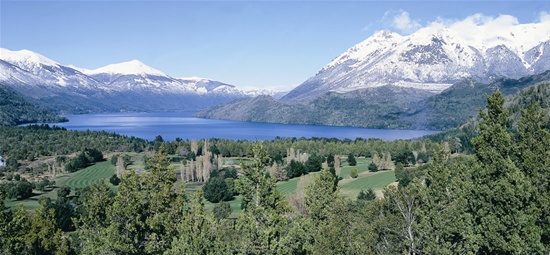The Andes Mountains: an endless universe See map
The Andes Mountains, west of Patagonia, is the frame of this stunning region. There, the particular combination of woods, lakes and mountains with almost untouched nature, it has become a magnet for tourists from around the world. It extends from the north of Neuquén to the south of Tierra del Fuego.
 Gutierrez lake view and mountain ranges in the city of San Carlos de Bariloche. Photo of courtesy of EMPROTUR.
Gutierrez lake view and mountain ranges in the city of San Carlos de Bariloche. Photo of courtesy of EMPROTUR.
The mountain is a geographical feature product of the movement of tectonic plates during the Mesozoic. In this way, the Andes rise because the oceanic plates sink beneath the South American plate. Thus arose the mountains and volcanoes that now comprise the Cordillera de los Andes, stretching from Venezuela to Tierra del Fuego by 7500 kilometers. It is characterized by its high altitude with numerous volcanoes, being the Aconcagua in Mendoza, of 6,959 meters above sea level, the highest in the mountain range.
In Patagonia, the Andes is synonymous of places with unparalleled beauty. Lakes, rivers, hills, mountains, volcanoes, waterfalls and many natural attractions are the frame that gives it that magic to the mountain.
It is the place chosen by thousands of tourists to relax and enjoy the contact with nature, and also to practice plenty of outdoor sporting activities. Trekking, climbing, rappelling, rafting, kayaking, horseback riding and mountain biking are some options for exploring the vastness of the Andes.
Among the main destinations we can mention in the province of Neuquen Caviahue and Copahue, San Martín de los Andes and Villa La Angostura; the eternal Bariloche and the hippie town of El Bolsón in Río Negro; and the capital of La Trochita in Esquel in Chubut.
Pero también existen innumerables cantidades de localidades que conforman la cordillera y son de singular belleza. For example Villa Pehuenia, Villa Traful or Chos Malal in Neuquén, the Comarca of Parallel 42 (where they are located Cholila, Lago Puelo, Epuyén, El Maitén and El Hoyo) and Trevelin in Chubut or the cherry capital, Los Antiguos, and Perito Moreno in Santa Cruz.
Alojamiento en San Carlos de Bariloche
 Hostería Hostería del Cerro
Hostería del Cerro ofrece una atmósfera de tranquilidad. Sus departamentos cuentan con cocina, televisiónver másTel: San Carlos de Bariloche
Hostería Hostería del Cerro
Hostería del Cerro ofrece una atmósfera de tranquilidad. Sus departamentos cuentan con cocina, televisiónver másTel: San Carlos de BarilocheViajes por la Patagonia
Related Articles
© Patagonia.com.ar 2025 | Todos los derechos reservados.
